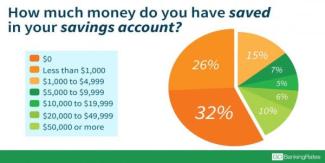
In Case of Emergency, Break Glass
It has been over 30 days since the government shutdown. Over 800,000 federal employees have had to rely on other means to cover their daily needs. From filing for unemployment benefits, to getting part-time jobs and in more desperate attempts, selling vehicles to cover expenses. It is difficult to imagine oneself in their shoes as it is stressful to think about one’s own cash flows, let alone someone else’s.
It is situations such as these where we cannot stress enough the significance of a funded emergency fund. Disturbingly, savings rates for the average American are still at a low.
Ideally, should an unforeseen event occur, the logistics of meeting one’s basic needs should not be a massive concern as a well-funded emergency fund should be able to cover short-term needs. But in the real world, it can be difficult to effectively establish one. For those living paycheck-to-paycheck or those in need of government assistance, they are constantly finding themselves at an intersection of survival and emergency.
Individuals who have an insufficiently-fund or depleted emergency fund should considering other possible sources of liquidity such as:
- 401(k), 403(b), or 457 Hardship withdrawals or Loans (Check your plan to see what’s available for you)
- IRA Withdrawals (Withdrawal tax penalties can apply)
- HELOCs or Home Equity Line of Credit (For Homeowners, keeping one open is a valuable back-up)
- Credit Cards (Try to limit this as a final resort)
For those of us who do have the means and overlook the choice to save into an emergency fund, is there really a valid reason that you have for choosing NOT to save into this? Take a look at the chart above once again, and consider your place there. Are you content about your place in the chart?
Lastly, here a few tips to keep in mind when starting or adding to an emergency fund are:
- Set incremental funding goals: Ultimately, you should have 3-6 months of expenses in an emergency fund. Starting from $0 and trying to get to $20,000 can feel intimidating. Pat yourself on the back after saving $1,000 increments. Over time, this will build up and you will be surprised about how far you have come.
- Accessibility: There are various locations where you can keep this fund. Interest-bearing savings accounts, short-term & no-penalty CDs, or high-yield money market funds are some options where this money can be set aside and put to work for you. Many online savings banks are now offering yields of 2% or more with no minimums.
- Set Up Systematic Deposits: This will prevent you from forgetting to save while also forcing you to save. Decide now how much you can save, set-up a systematic deposit to your savings, and then make a note to re-evaluate in a few months. You should aim to slowly increase your monthly savings.
- Know Your Necessary Expenses: If you do find yourself in a situation where you have to draw from the emergency fund, having a preplanned budget to go along with this fund can eliminate the worry of how to spend this limited resource until you get back on your feet.
- Stick to The Plan: As long as your cash inflows remain stable, don’t stop until you’ve reached that dollar amount. Don’t cut back on this month’s saving quota just because last month you saved much more than you should have.

